Is it art? Documentary photography at the New York Photo Festival
The question of whether photography can be art was settled a long time ago. Most major museums now have thriving photography departments, and photographs fetch pretty hefty prices at auction. But the question of whether social documentary photography can be art has proven to be a bit more vexing. When a photograph is initially made as a piece of advocacy or reportage, what does it mean when it’s transferred to the rarified air of the art gallery?
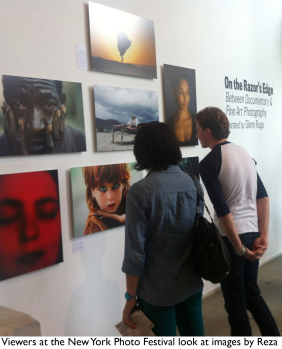 This was one of the nuts that the New York Photo Festival set out to crack last week in Brooklyn, and it felt very timely. Maybe it’s just me, but I feel like the recession has made people a bit more socially conscious and willing to grapple with tough issues. This has opened up an atmosphere where audiences are more receptive to hard-hitting documentary photographs in art contexts, and therefore galleries are more willing to show them.
This was one of the nuts that the New York Photo Festival set out to crack last week in Brooklyn, and it felt very timely. Maybe it’s just me, but I feel like the recession has made people a bit more socially conscious and willing to grapple with tough issues. This has opened up an atmosphere where audiences are more receptive to hard-hitting documentary photographs in art contexts, and therefore galleries are more willing to show them.
What does this mean for the work, though? Clearly there’s a tension between the values of the art market and those of the social documentarian. I recently went to the new Yossi Milo Gallery in Chelsea to see a show of photographs by Tim Hetherington, the war photographer who was killed last year in Libya. I admire Hetherington’s work, but even so it a bit felt jarring to see his images of Liberian child soldiers and decrepit hospitals commodified into beautiful 4′ x 4′ art prints. The contrast between the dirty-colorful, poverty-stricken Liberian landscape and the perfect white walls of the gallery was ironic to say the least.
So I was intrigued to see that the New York Photo Festival had made social documentary photography a prominent feature this year, and that the issue of whether it can be art was also front and center. The area where art photography and documentary photography overlap is “the largest interplay in the photo world in general,” festival organizer Daniel Power told me. Yet as guest curator Glenn Ruga wrote in his thoughtful opening statement, the relationship between documentary photography and fine art photography is often uncomfortable, with a prevailing attitude that “tendentious work—work that has a motive beyond pure ‘artistic’ pleasure—is tainted and beneath work that is purely fine art.”
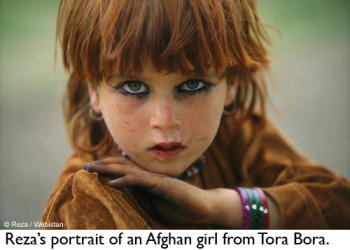 The festival set out to counter that mindset, and I think it was hugely successful. The Razor’s Edge: Between Documentary and Fine Art Photography featured the work of six prominent documentary photographers. It ranged from the self-consciously arty (Eugene Richards‘ elegiac color images of abandoned rural American homes) to direct advocacy (Platon‘s stark black-and-white portraits of Egyptian revolutionaries, taken for Human Rights Watch) and several things in between, including some stunning color portraits like the one on the right by National Geographic photographer Reza.
The festival set out to counter that mindset, and I think it was hugely successful. The Razor’s Edge: Between Documentary and Fine Art Photography featured the work of six prominent documentary photographers. It ranged from the self-consciously arty (Eugene Richards‘ elegiac color images of abandoned rural American homes) to direct advocacy (Platon‘s stark black-and-white portraits of Egyptian revolutionaries, taken for Human Rights Watch) and several things in between, including some stunning color portraits like the one on the right by National Geographic photographer Reza.
In a panel discussion on Thursday night, five photographers from The Razor’s Edge hashed out some of the issues in the art versus documentary debate. Lori Grinker talked about how she uses graphic elements to draw viewers into an image, saying, “I often think of people passing something by every day and not noticing it.” National Geographic photographer Reza (who will be played by Sir Ben Kingsley in the movie of his life) said his images “have to really impress people, so I make them simple.” Richards talked about the emotional pull of color, which he discovered recently while making images for his book about abandoned homes, The Blue Room.
The panelists didn’t really touch on the issue of how they felt about the different outlets for their work, except for Richards, who said it was getting harder and harder to find media placement for his images. “I wish I could be confident they’d get out there,” he said. Bruce Davidson talked about how he’d recently spent two years going through all his old contact sheets, finding that his evaluation of many images had changed. “I wasn’t emotionally ready to understand them before,” he said.
Using the language of fine art in photography is nothing new, of course. Look at the way Lewis Hine self-consciously modeled his ‘Madonna of the Tenements’ after Raphael’s ‘Madonna of the Chair.’
I don’t think Hine was doing this in a bid to be accepted as an art photographer; he simply realized that certain tropes in fine art are undeniably powerful, and would work equally well for photographs. I was reminded of that in the panel discussion when Platon, who was a high-profile celebrity portrait photographer before he began working with Human Rights Watch, talked about how he brings his commercial photography toolbox to his work with Human Rights Watch. “I know how to make an image that sells,” he said. “I know how to make an image that stops cars in the street.” (To be honest, I’m not a huge fan of Platon’s signature white backdrop and tone-flattening flash, but his image of Egyptian singer Ramy Essam certainly got my attention):
There was some other stunning work in the festival too. A show called The Art of Documentary, with work drawn from an open call on Ruga’s excellent web site SocialDocumentary.net, showed that social documentary work is thriving despite the shrinking media space for it. The work was uncompromising and often breathtakingly beautiful. I especially liked Leslie Alsheimer’s project on young girls in Uganda, A Moment in the Glass: The Secret Life of Uganda’s Daughters.
The documentary part of the festival “drew much larger crowds than the other exhibits,” Ruga told me early this week (the event portion of the festival is now over, but exhibitions can be viewed through May 31). In his opinion, this is because the work is more accessible to a larger audience. With conceptual art, “there is a veneer of obfuscation that often must be crossed before one can read the language of the work. With documentary, on the other hand, the message is more on the surface and whether it is successful or not can be determined much more quickly.”
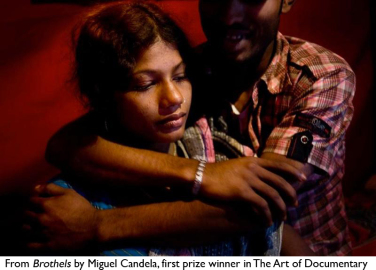 Or, to draw a literary analogy, social documentary work is like kitchen sink realism—like reading a novel by John Updike or Hanif Kureishi or Zadie Smith. It offers us a chance to observe our fellow humans in depth, with all their frailties and strengths. It shows us powerful universal emotions in an unfamiliar context, and demands empathy from us.
Or, to draw a literary analogy, social documentary work is like kitchen sink realism—like reading a novel by John Updike or Hanif Kureishi or Zadie Smith. It offers us a chance to observe our fellow humans in depth, with all their frailties and strengths. It shows us powerful universal emotions in an unfamiliar context, and demands empathy from us.
Is it art or not? In the end, perhaps that doesn’t matter too much. A label is just a label. I started out by saying that it was jarring to see Tim Hetherington’s work in a gallery context, but I’d sure as hell rather see it there than look at a shark pickled in formaldehyde. I’ve seen some really good conceptual art recently, but it doesn’t get me in the gut in the same way social documentary photography does. So yes, it was exciting to see this work being given such prominence and consideration at a festival. The old ways of distribution might be disappearing, but on the evidence of the New York Photo Festival, social documentary photography is alive and well. Let’s be thankful for that.
________________________________________________________
Some great photographers I discovered at the festival:
Christian Witkin (his portraits from India, Thailand, Ethiopia and NYC are amazing)
Angelo Merendino (sad but beautiful story about his wife’s battle with breast cancer)
Leslie Alsheimer (great work from Uganda)
Irmelie Krekin (evocative images of childhood)
11 comments on “Is it art? Documentary photography at the New York Photo Festival”
Leave a Reply
Connecting to %s

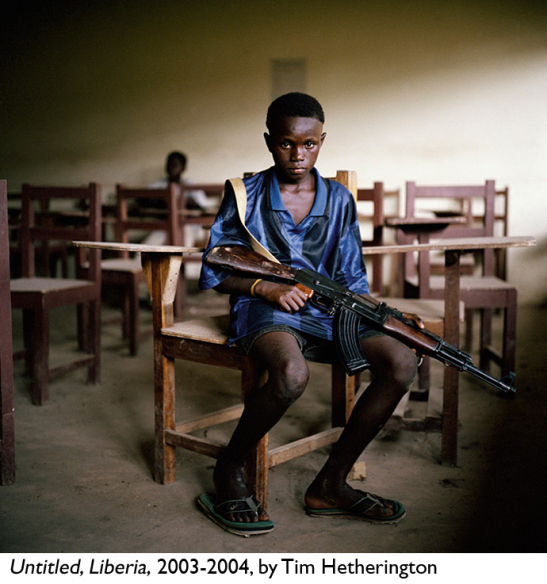
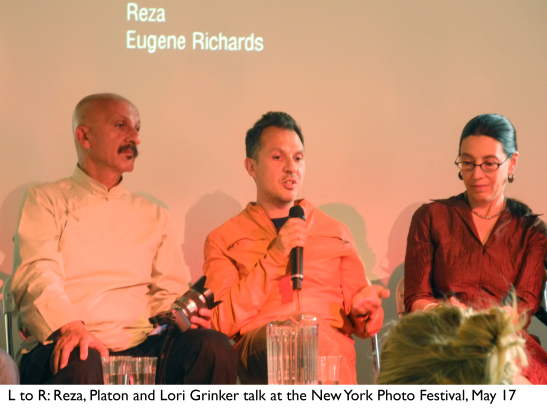
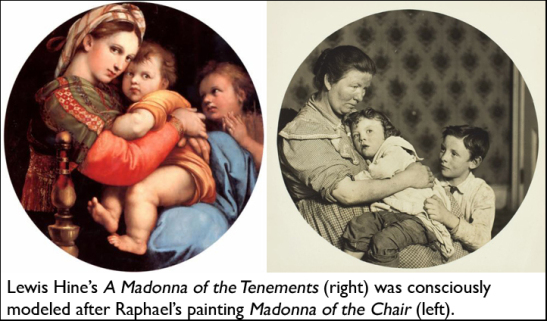
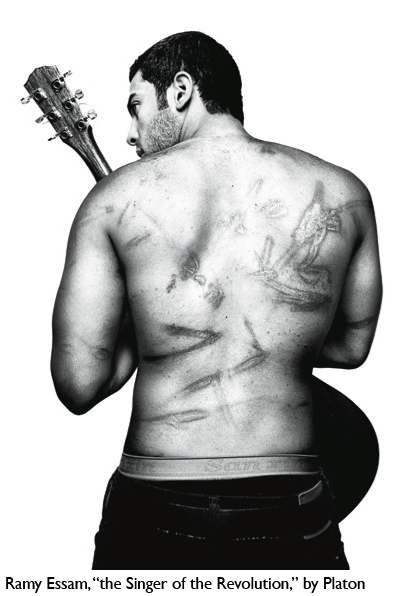
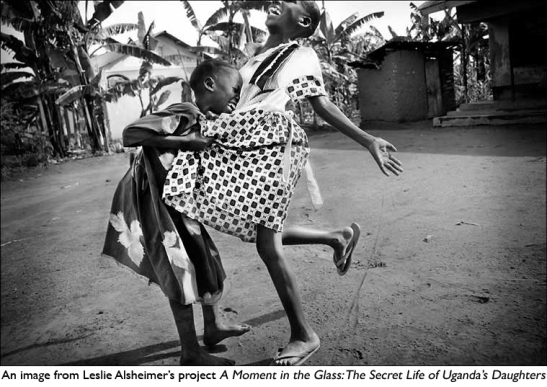

writing is a great art and so is photogrphy. I believe that no amount of words can take the place of a picture. This page is exciting. I enjoy reading it and the pictures.
Thanks for reading, Eteobong! Photography and writing are both amazing art forms on their own, but I think there are some times when a combination of the two is needed to tell a complete story. I love when I find projects where the words and images enhance each other.
Sarah. Thanks for the summary of the events at the festival and honing in on the central issues. Best. Glenn
The New York Photo Festival of 2012 was the most disappointing occurrence of this event in its short history. It was poorly attended and the range and scope of the work presented was much narrower than in previous years. There was a tremendous disparity in the quality of work – a few very well known documentary photographers and a much larger number of quasi-student presenters. The festival represented a major failing on the part of the curators. But that’s probably not the curators’ fault. The festival organizers, in their attempt to pander to the pap and drivel of modern culture settled for second rate pseudo-intellectuals who did their best to present a face of culture and sophistication. Alas, it was way beyond their capabilities.
Conceptual photography is a pretentious joke. If I could find that poser with the shark(DH), I would kick him in his likely non existent balls.
I must say it’s about time that this start this discussion seriously. Without getting into the profit-bussines dead end aspect, documentary photography MUST be separated from art. It has nothing to do with it. Art must be sublime, timeless and beatufull. On the other hand I don’t think that documentary photography doesn’t gets its attention. On the contrary, I am very consious of it’s impact to humanity, and it should be strongly supported.
In our new tech age, compared to not more then 20 years ago, things have changed, documentary photography can get it’s attention in every media thinkable, but it had NOTHING to do in art gallery.
Thanks for this thoughtful perspective. I appreciate your point of view, but I think it can also be useful sometimes to see documentary photography out of context, e.g. in an art gallery. It makes us think differently about art and about documentary, and realize that the two often overlap. Like many people, I am fascinated by the fact that powerful documentary photographs often employ artistic techniques, and that documentary photographers must constantly think about aesthetics along with content.
Photography is an art, it is expression of emotional power of human nature which reveals hidden stories, shows the truth..
Reblogged this on Community Photographer.
Thank you! Much appreciated.
i had no idea this was a debate at any point in time, seems insane to the point of impossibility to me that anyone could ever lobby against photography as an art form at any time, past or present.
best example i could give that transcends over a very large course of time that multi-generations can draw from is Time/Life magazine covers, content and timelessness.
perfect example of when documentation meets artist(photographer) meets art(final product/photo).
compare these with various non/artistically captured images of war that have taken an entirely new life as time has passed and the difference is clear.
photography not an art? ridiculous.
good read, thanks